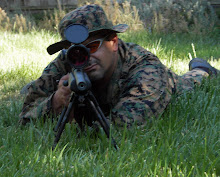I decided to build a new dew shield for my telescope.
Why you ask? Because I thought it would be an interesting project and I didn't have one for my CGEM.
I plotted out what I would need to buy to complete the project, here was my shopping list:
- 24 inch wide aluminum flashing, this is a very light and flexible material (not sure if it will be rigid enough, but a good first try :-))
- flat black spray paint, for both the inside and outside of the dew shield
- pop rivet set (black pom / hand rivet tool)
At a minimum this should give me a very light, dew shield that will protrude about 24 inches from the primary objective lens. Offering a good amount of both dew and ambient light blockage.
I am a little worried about the rigidity of the aluminum, but getting it cut and formed will tell me a little bit more about the material and it's weaknesses.
Happy Photon Hunting!
Saturday, June 25, 2011
Wednesday, June 15, 2011
Any night is a great night for Astronomy
Tonight is June 15th, the moon is in the Waining Gibbous phase, meaning that it is illuminated at about 99.73 (or so) percent, pretty much a full moon to most people. That means that there is so much light in the sky that you can only see a handful of stars. The moon is also so low on the horizon that it is pretty much unable to be viewed in my telescope.
About now you might be asking yourself, so why is Ken saying that any night is a great night for astronomy? He can't even see a thing through his telescope because of all the light of the moon and can't even see the moon due to tree coverage.
Let me let you in on a little secret... Shhh, don't tell anyone, but...
Astronomy is a hobby that requires instruments, some that are as in expensive as a set of binoculars, while other instruments may be as (or more) expensive than an automobile, but they are all instruments and just like musical instruments or other scientific instruments, they take practice and sometimes tuning to ensure optimal performance when you need them.
So being the boring guy that I am, I took this evening to do a couple of fun tuning activities for my scope, here is what I did:
1) I checked mechanical zero against my mounted optics to make sure that everything was aligned and operating as it should.
2) I tried out my brand new dew shield, one that I designed and fabricated myself out of lightweight aluminum (worked as expected, but saw some areas of improvement that I will work on this week).
3) tested my optics for collimation, which to my surprise was remarkably aligned, about as close as one could reasonably expect, can't ask more than that. :-)
4) tested the new bhatinov mask that I fabricated for this scope, the legs of the stars came out brightly, slowing for pinpoint focus of the stars.
So even though I wasn't able to see some of the skies wonders tonight, I was able to dial in my instruments to a fine level of precision, ensuring that when the moon and the atmosphere provide me more optimal viewing opportunities, I will be ready and able to take in the beauty of our universe, one object at a time.
Happy Photonic Hunting!
About now you might be asking yourself, so why is Ken saying that any night is a great night for astronomy? He can't even see a thing through his telescope because of all the light of the moon and can't even see the moon due to tree coverage.
Let me let you in on a little secret... Shhh, don't tell anyone, but...
Astronomy is a hobby that requires instruments, some that are as in expensive as a set of binoculars, while other instruments may be as (or more) expensive than an automobile, but they are all instruments and just like musical instruments or other scientific instruments, they take practice and sometimes tuning to ensure optimal performance when you need them.
So being the boring guy that I am, I took this evening to do a couple of fun tuning activities for my scope, here is what I did:
1) I checked mechanical zero against my mounted optics to make sure that everything was aligned and operating as it should.
2) I tried out my brand new dew shield, one that I designed and fabricated myself out of lightweight aluminum (worked as expected, but saw some areas of improvement that I will work on this week).
3) tested my optics for collimation, which to my surprise was remarkably aligned, about as close as one could reasonably expect, can't ask more than that. :-)
4) tested the new bhatinov mask that I fabricated for this scope, the legs of the stars came out brightly, slowing for pinpoint focus of the stars.
So even though I wasn't able to see some of the skies wonders tonight, I was able to dial in my instruments to a fine level of precision, ensuring that when the moon and the atmosphere provide me more optimal viewing opportunities, I will be ready and able to take in the beauty of our universe, one object at a time.
Happy Photonic Hunting!
Subscribe to:
Comments (Atom)
